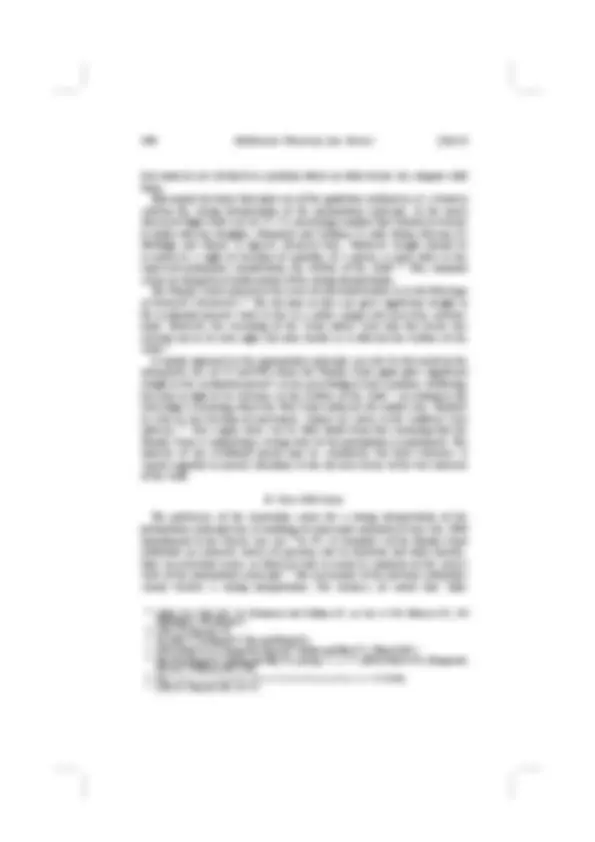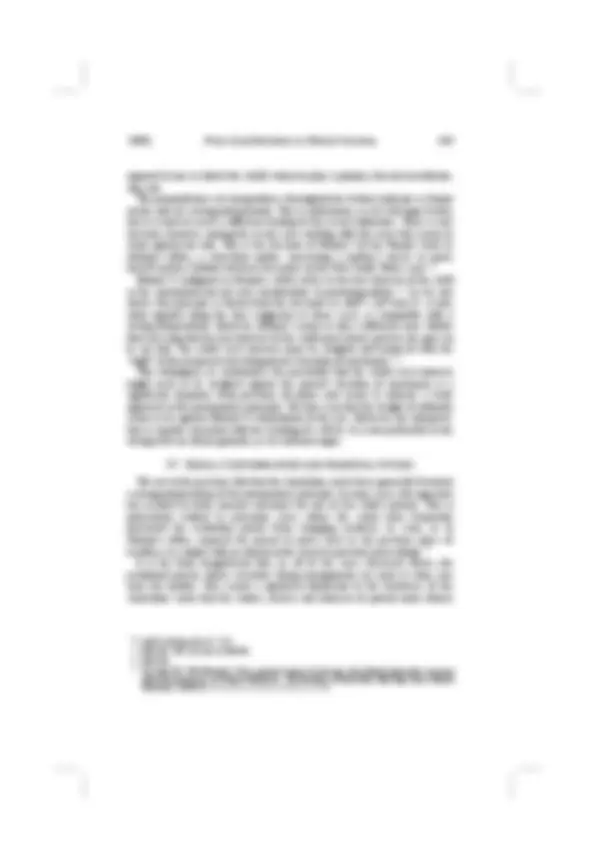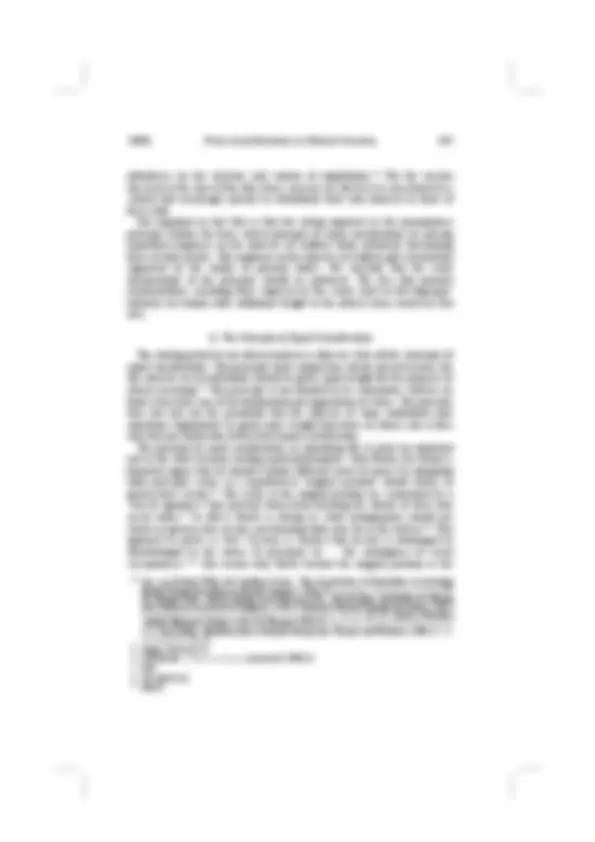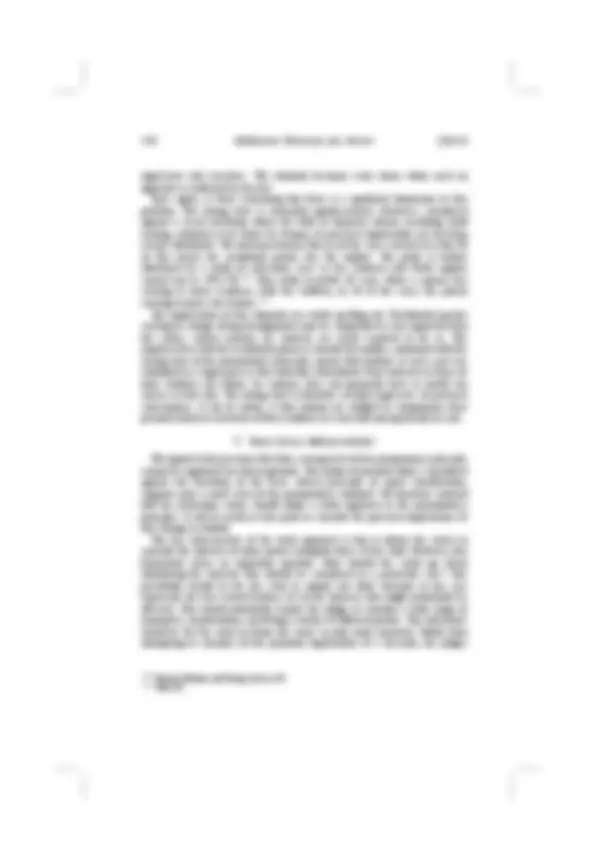


















Study with the several resources on Docsity

Earn points by helping other students or get them with a premium plan


Prepare for your exams
Study with the several resources on Docsity

Earn points to download
Earn points by helping other students or get them with a premium plan
Community
Ask the community for help and clear up your study doubts
Discover the best universities in your country according to Docsity users
Free resources
Download our free guides on studying techniques, anxiety management strategies, and thesis advice from Docsity tutors
This article undertakes an ethical assessment of the paramountcy principle as interpreted by the Australian courts. Our focus is not on the meaning of the term.
Typology: Exercises
1 / 24

This page cannot be seen from the preview
Don't miss anything!

















[The notion of the ‘best interests of the child’ plays a central role in Australian family law. Section 60CA of the Family Law Act 1975 (Cth), as amended in 2006, reiterates the longstanding principle that, in making a parenting order, ‘a court must regard the best interests of the child as the paramount consideration’. The Australian judiciary has adopted a strong interpretation of the paramountcy principle, according to which the interests of children prevail absolutely over the interests of all other parties. The authors argue that such a strong emphasis on children’s interests cannot be ethically justified; only a weak view of the paramountcy principle can be supported on ethical grounds.]
C O N T E N T S
I Introduction............................................................................................................. 391 II The Paramountcy Principle..................................................................................... 393 A ‘Best Interests of the Child’ ....................................................................... 394 B ‘Paramount Consideration’ ........................................................................ 395 III Judicial Interpretations............................................................................................ 396 A Pre-2006 Cases........................................................................................... 397 B Post-2006 Cases ......................................................................................... 400 IV Equal Consideration and Parental Duties ............................................................... 403 A The Principle of Equal Consideration ........................................................ 405 B The Scope of Parental Duties..................................................................... 407 V Practical Implications ............................................................................................. 410 VI Conclusion .............................................................................................................. 413
I I N T R O D U C T I O N Section 60CA of the Family Law Act 1975 (Cth) (‘ Family Law Act ’) states that, ‘in deciding whether to make a particular parenting order in relation to a child, a court must regard the best interests of the child as the paramount consideration.’^1 This standard is often called the ‘paramountcy principle’. The provision, introduced in 2006,^2 superseded s 65E, which was phrased in identical
392 Melbourne University Law Review [Vol 33
terms.^3 This strong emphasis on the interests of children has been enshrined in Australian family law since at least 1976, when the Family Law Act first came into force. The original Act stipulated in s 64(1)(a) that in a range of proceedings concerning children ‘the court shall regard the welfare of the child as the paramount consideration’.^4 Despite a number of subsequent amendments to the Family Law Act , this basic principle has remained intact.^5 This article undertakes an ethical assessment of the paramountcy principle as interpreted by the Australian courts. Our focus is not on the meaning of the term ‘best interests of the child’, which has been extensively discussed elsewhere. 6 Rather, we focus on the requirement that the child’s interests should be the paramount consideration in parenting matters — an issue that has received remarkably little attention in its own right. We argue that only a relatively weak interpretation of the requirement can be supported on ethical grounds. It is important to emphasise at the outset that we wholly agree with the general motivations behind the wording of s 60CA. The strong focus on the interests of the child in that provision reflects the special vulnerability of children as moral persons as well as the distinctive ethical duties owed by parents to their offspring. After all, parents make virtually all the significant decisions about a child’s life, so they have an obligation to consider the child’s interests in making those decisions. In practical terms, the paramountcy principle aspires to discourage an excessively adversarial approach to parenting agreements, thereby alleviating some of the harm that children suffer as a result of parental conflict.^7 The requirement that the best interests of the child be paramount in parenting matters is grounded in the legitimate claim of children to have their ethical interests taken into account. Nonetheless, in purporting to give the best interests of the child absolute priority over the interests of all other parties, the prevailing interpretation of the paramountcy principle goes further than is ethically warranted. Our aim in this article is therefore to consider how the good intentions reflected in the principle can best be translated into ethical outcomes. The article begins in Part II by distinguishing two possible approaches to interpreting the paramountcy principle, which we call the ‘strong’ and ‘weak’
(^3) Family Law Act s 65E, repealed by Family Law Amendment (Shared Parental Responsibility) Act 2006 (Cth) sch 1 item 32. (^4) Family Law Act s 64(1)(a), repealed by Family Law Amendment Act 1987 (Cth) s 26(b). (^5) See, eg, Family Law Act ss 63H(2), 65L(2), 67L, 67V. See also Richard Chisholm, ‘“The Paramount Consideration”: Children’s Interests in Family Law’ (2002) 16 Australian Journal of Family Law 87, 109. (^6) See, eg, Vicky Kordouli, ‘Relocation — Balancing the Judicial Tightrope’ (2006) 20 Australian Journal of Family Law 89; Patrick Parkinson, ‘Decision-Making about the Best Interests of the Child: The Impact of the Two Tiers’ (2006) 20 Australian Journal of Family Law 179; Donald M Thomson, ‘Beyond the Rhetoric of Best Interests of the Child’ (2005) 7 Australian Journal of Professional and Applied Ethics 58; Frank Bates, ‘Children’s Best Interests in Australia: Camouflage, Persiflage or What?’ [2005] International Family Law Journal 138; Juliet Behrens, ‘ U v U : The High Court on Relocation’ (2003) 27 Melbourne University Law Review 572, 572–82. (^7) For a recent study on the impact of parental conflict on children, see Jennifer McIntosh and Caroline Long, ‘Current Findings on Australian Children in Postseparation Disputes: Outer Conflict, Inner Discord’ (2005) 11 Journal of Family Studies 99.
394 Melbourne University Law Review [Vol 33
the specificity of some aspects of the process.^11 In particular, judges must decide both what is meant by the ‘best interests of the child’ and what it means for that to be treated as the ‘paramount consideration’. The interpretive leeways afforded by the paramountcy principle mean that judicial understandings of the standard are crucial in determining its practical implications.
A ‘Best Interests of the Child’ The discretion enlivened by the term ‘best interests of the child’ is limited to some extent by the current ss 60CC–60CG, which set out in greater detail how the court is to determine what is in a child’s best interests. Section 60CC, in particular, lists two primary considerations and a number of additional considerations that the court must have regard to. However, the wording of that provision creates its own range of discretions, requiring the judge to determine both how the various factors relate to the case at hand and what weight should be given to each factor. Section 61DA, inserted in 2006,^12 creates a presumption that equal shared parental responsibility is in the best interests of the child. However, that presumption can be rebutted in particular cases.^13 A useful distinction when considering the interpretation of ‘best interests of the child’, introduced by Vicky Kordouli, is that between ‘narrow’ and ‘wide’ approaches.^14 The narrow view confines itself to a limited range of issues that impact directly on the child’s wellbeing.^15 The wide approach, by contrast, recognises that the wellbeing of the parents may impact on the child and therefore takes parental interests into account insofar as they affect the child’s welfare.^16 Kordouli argues that the narrow approach has been preferred in recent times by the High Court of Australia, while the Family Court of Australia has generally adopted the wide interpretation.^17 It bears noting that the above distinction, while certainly significant, does not address the question of whether the interests of the child should always prevail over those of the parents and other parties. Rather, it considers whether the interests of the parents should be taken into account when seeking to determine what is in the child’s best interests. In other words, the distinction concerns the interpretation of ‘best interests of the child’, rather than the interpretation of ‘paramount’. Once the child’s best interests have been determined, using either a narrow or a wide approach as defined by Kordouli, it may still be necessary for the court to determine whether those interests should prevail over other factors.
(^11) See Family Law Amendment (Shared Parental Responsibility) Act 2006 (Cth) sch 1 item 9. See also Parkinson, ‘Decision-Making about the Best Interests of the Child’, above n 6, 180–2, 191–2. (^12) Family Law Act s 61DA, inserted by Family Law Amendment (Shared Parental Responsibility) Act 2006 (Cth) sch 1 item 13. (^13) Family Law Act s 61DA(4). (^14) Kordouli, above n 6, 90. (^15) Ibid. (^16) Ibid. (^17) Ibid.
2009] From Good Intentions to Ethical Outcomes 395
B ‘Paramount Consideration’ It is the issue of whether and to what extent the best interests of the child should be weighed against other considerations in making parenting orders which will concern us in the rest of this article. The term ‘paramount’ in s 60CA, unlike the expression ‘best interests of the child’, has generated no real legislative guidance. Its prevailing meaning is therefore largely a product of judicial interpretation. A useful theoretical framework for categorising different possible approaches to the paramountcy principle is provided by the distinction, suggested by Richard Chisholm,^18 between ‘strong’ and ‘weak’ views of the principle. The strong view of the paramountcy principle can be straightforwardly expressed. According to Chisholm, this approach calls for two steps on the part of the court.^19 The first step is to ‘identify what orders will be most likely to promote the child’s best interests’.^20 The second and final step is simply ‘to make those orders.’^21 In other words, the strong view assumes that the best interests of the child is the only factor that may be considered in making a determination; it effectively overrides any other interests that may be affected. We might encapsulate this view of the paramountcy principle as follows:
Strong View — The best interests of the child is the only factor to be consid- ered in making a determination. It overrides any other relevant considerations or interests (no matter how significant). Chisholm regards the weak view of the paramountcy principle as more difficult to summarise. 22 His preferred statement of the weak view is a negative one: it ‘does not necessarily require the court to make whatever order it thinks best for the child, regardless of other things.’^23 According to this approach, the best interests of the child may sometimes give way to other factors. We might summarise this conception of the paramountcy principle as follows:
Weak View — The best interests of the child is the primary factor to be consid- ered in making a determination. However, it may sometimes be overridden by other relevant considerations or interests. The difficulty in stipulating the exact content of the weak approach to the paramountcy principle arises in relation to two matters: first, what competing considerations or interests may be taken into account; and, secondly, to what extent these competing factors may be considered.^24 Are there any limits on the competing factors that may be countenanced? How strong do these factors have to be to outweigh the best interests of the child? We will return to these issues in
(^18) Chisholm, above n 5, 88–95. (^19) Ibid 89. (^20) Ibid. (^21) Ibid. (^22) Ibid 93. (^23) Ibid (emphasis in original). (^24) Ibid 93–4.
2009] From Good Intentions to Ethical Outcomes 397
courts. While judicial statements in a few cases indicate a weak view of the principle, these passages run against the general tenor of decisions in this area. The preference by the Australian judiciary for a strong interpretation makes it all the more pressing to consider whether that view can be ethically supported. Our discussion of cases in this Part focuses particularly on relocation matters, where the residential parent seeks permission to relocate with the children. These types of cases dominate recent judicial decisions on the paramountcy principle. They also provide a particularly stark illustration of the different outlooks represented by the strong and weak approaches to the paramountcy principle, since they directly raise the issue of whether the residential parent’s freedom of movement may be considered in its own right or merely as an aspect of the child’s welfare. However, the ethical arguments advanced later in this paper have implications that extend beyond relocation scenarios. The full practical implications of our proposed framework will be examined more closely in Part V below.
A Pre-2006 Cases Chisholm argues in his article on the paramountcy principle that Australian decisions since the early 1980s have clearly favoured a strong interpretation.^30 This trend appears to have continued since that article was published in 2002. It is worthwhile, before moving on to more recent decisions, to revisit some of the cases that Chisholm considered. This is because, in our view, some of the passages that he reads as ambiguous or favouring a weak approach to the paramountcy principle are, in fact, consistent with a strong interpretation and have been interpreted as such in subsequent cases. This further bolsters Chisholm’s conclusion that Australian jurisprudence tends to favour a strong approach. It is useful to begin with the decision of the Full Court of the Family Court in the leading case of B and B: Family Law Reform Act 1995 (‘ B and B ’). 31 This decision, which has often been cited, seems to evince a clear preference by the Family Court for a strong view of the paramountcy principle. The Court describes the best interests of the child as the ‘paramount or pre-eminent consideration’;^32 it is the ‘final determinant’ of what orders the court must make.^33 Later in the judgment, when considering the specific issues that arise in relocation cases, the Court affirmed that, while ‘a general right of freedom of movement is a right recognised by Australian law’, nonetheless ‘in proceedings under Pt VII [of the Family Law Act ] it is a right that cannot prevail over what is considered to be in the best interests of the children in a particular case.’^34 This
(^30) Chisholm, above n 5, 89. (^31) (1997) 21 Fam LR 676. (^32) Ibid 730 (Nicholson CJ, Fogarty and Lindenmayer JJ). (^33) Ibid 733. (^34) Ibid 747.
398 Melbourne University Law Review [Vol 33
refusal to weigh the child’s best interests against the rights of other parties clearly indicates a strong view of the paramountcy requirement. The High Court then had occasion to consider its approach to the paramountcy principle in AMS v AIF. 35 This case, like B and B , required the court to decide whether to permit the residential parent to relocate with her child. The leading judgment in the case, which again has been widely cited, was delivered by Kirby J. A number of comments in that judgment advert to the strength that should be attributed to the paramountcy principle. At first glance, however, the remarks do not all lead in the same direction, which has led to some subsequent confusion in interpreting the relevant principles.^36 To begin with, Kirby J remarks that, while the best interests of the child is the paramount consideration in parenting matters, ‘it is not … the “sole” or “only” consideration.’^37 His Honour then states that ‘a statutory instruction to treat the … best interests of the child as the paramount consideration does not oblige a court … to ignore the legitimate interests and desires of the parents.’^38 These comments, so far, may seem to indicate a sympathy for a weak view of the paramountcy principle. In the very next sentence, however, Kirby J goes on to say that, if there is a conflict between the interests of the child and those of the parents, ‘priority must be accorded to the child’s welfare and rights.’^39 This seems an unequivocal endorsement of the strong interpretation, an impression bolstered by the later comment that ‘the touchstone for the ultimate decision must remain the … best interests of the child and not, as such, the wishes and interests of the parents.’^40 Kirby J’s insistence that the best interests of the child are not the sole consid- eration in parenting matters, coupled with his later comment that the child’s interests must always prevail over other factors, has caused some confusion in later decisions.^41 Chisholm suggests that some passages in the judgment support a strong view of the paramountcy principle, while others suggest a weak interpretation.^42 The better view, in our opinion, is that Kirby J’s comments are all consistent with a strong approach to the principle, although his choice of words is somewhat confusing. It will be helpful to briefly explain this interpretation. The question that Kirby J’s comments raise is as follows. How could it be the case that the best interests of the child are not the sole consideration, when they
(^35) (1999) 199 CLR 160. (^36) For example, Behrens comments that AMS v AIF ‘may be said to have lacked a clear ratio decidendi’ and suggests it was unclear whether the High Court in that case supported a strong or a weak view of the paramountcy principle: Behrens, ‘ U v U : The High Court on Relocation’, above n 6, 575, 582. Chisholm takes a similarly equivocal view of the case: see Chisholm, above n 5, 107. (^37) AMS v AIF (1999) 199 CLR 160, 207. A similar comment is made by Gaudron J at 191–2. (^38) Ibid 207. (^39) Ibid. (^40) Ibid 208 (Kirby J). (^41) See, eg, A v A: Relocation Approach (2000) 26 Fam LR 382, 399, 404 (Nicholson CJ, Ellis and Coleman JJ). (^42) Chisholm, above n 5, 107.
400 Melbourne University Law Review [Vol 33
best interests are elevated to a position where no other factor can compete with them. Subsequent decisions that make use of the guidelines outlined in A v A tend to confirm the strong interpretation of the paramountcy principle. In the much discussed High Court case of U v U , concerning a mother who wished to relocate to India with her daughter, Gummow and Callinan JJ, with whom Gleeson CJ, McHugh and Hayne JJ agreed, observed that, ‘whatever weight should be accorded to a right of freedom of mobility of a parent, it must defer to the expressed paramount consideration, the welfare of the child’.^49 This comment seems an unequivocal endorsement of the strong interpretation. The Family Court returned to the issue of relocation briefly in In the Marriage of Butterell (‘ Butterell ’). 50 The decision in that case gave significant weight to the residential parent’s wish to live in a stable, happy and stress-free environ- ment. However, the reasoning of the Court makes clear that this factor was relevant not in its own right, but only insofar as it affected the welfare of the child.^51 A similar approach to the paramountcy principle can also be discerned in the unreported case of PJ and NW , where the Family Court again gave significant weight to the residential parent’s social, psychological and economic wellbeing, but only in light of its relevance to the welfare of the child.^52 According to the trial judge’s reasoning, which the Full Court endorsed, the mother was ‘entitled’ to exercise her freedom of movement, ‘subject of course to the children’s best interests.’^53 Once again, there can be little doubt from this reasoning that the Family Court is employing a strong view of the paramountcy requirement. The interests of the residential parent may be considered, but their relevance is clearly regarded as merely subsidiary to the decisive factor of the best interests of the child.
B Post-2006 Cases The preference of the Australian courts for a strong interpretation of the paramountcy principle has, if anything, become more pronounced since the 2006 amendments to the Family Law Act. 54 In W v R , Carmody J of the Family Court undertook an extensive survey of previous law in Australia and other jurisdic- tions on relocation issues, in which he had occasion to comment on the correct view of the paramountcy principle.^55 His assessment of the previous authorities clearly favours a strong interpretation. For instance, he noted that ‘[t]he
(^49) (2002) 211 CLR 238, 262 (Gummow and Callinan JJ); see also at 240 (Gleeson CJ), 249 (McHugh J), 284 (Hayne J). (^50) (2005) 33 Fam LR 150. (^51) See ibid 157–8 (Bryant CJ, Kay and Boland JJ). (^52) [2005] FamCA 162 (Unreported, Bryant CJ, Holden and May JJ, 15 March 2005). (^53) Ibid [19] (Bryant CJ, Holden and May JJ), quoting PJ and NW [2004] FamCA 221 (Unreported, Dessau J, 18 March 2004) [79]. (^54) See Family Law Amendment (Shared Parental Responsibility) Act 2006 (Cth). (^55) (2006) 35 Fam LR 608, 613–76.
2009] From Good Intentions to Ethical Outcomes 401
Australian version of the paramountcy principle is child not parent focused. The wants, needs and well-being of the children should override those of the parents.’^56 Carmody J goes on to offer the following interpretation of the ‘paramount but not sole’ formulation appearing in previous cases:
The best interests of the child(ren) concerned, both in the short and longer term, and not the interests or needs of the parents (let alone the interests of either one of them) are the paramount consideration. However, they are not the sole factor. The general quality of life and economic, cultural and psychological welfare of both parents, but particularly the residence parent, are relevant and important. Nonetheless, the child’s best interests have statutory priority and prevail over the legitimate rights, interests and expectations of all others, including the parents, in the event of conflict.^57
This passage seems to support the interpretation of AMS v AIF and A v A that we offered above in Part III(A). The welfare and interests of the parents are relevant insofar as they affect or bolster the outcome favoured by the best interests of the child, but they may never prevail over the child’s welfare. Taylor v Barker was another relocation case where the Full Family Court gave attention to the relevance of the happiness and welfare of the residential parent.^58 The treatment of the issue in that case was along similar lines to the approach adopted in Butterell. The reasoning of the trial judge, which was approved by the Full Court, was that if the mother were ‘forced to remain in Canberra … she would be unhappy and resentful.’^59 This was relevant because:
To a significant degree the happiness and contentment of [the child] depends on the happiness and contentment of his mother. … I am satisfied that it is in [the child’s] best interests that his mother be permitted to relocate to North Queen- sland.^60 Another recent case that seems to support the reading of AMS v AIF and A v A that we offered above is Mazorski v Albright. 61 The judgment of the Family Court in that case makes reference to both AMS v AIF and A v A. 62 It then goes on to reiterate that the approach in those cases does not mean that the parents’ interests should be ignored, but it does mean they must yield where they conflict with those of the child.^63 The best interests of the child are therefore not technically the sole consideration, but are nonetheless decisive.
(^56) Ibid 671. (^57) Ibid 672 (citations omitted). (^58) (2007) 37 Fam LR 461. (^59) Ibid 473 (Bryant CJ and Finn J), quoting Taylor v Barker [2006] FMCAfam 706 (Unreported, Brewster FM, 22 December 2006) [50]. (^60) Taylor v Barker (2007) 37 Fam LR 461, 473 (Bryant CJ and Finn J), quoting Taylor v Barker [2006] FMCAfam 706 (Unreported, Brewster FM, 22 December 2006) [50], [52]. (^61) (2007) 37 Fam LR 518. (^62) Ibid 522 (Brown J). (^63) Ibid.
2009] From Good Intentions to Ethical Outcomes 403
opposed to one in which the child’s interests play a primary, but not overwhelm- ing, role. The preponderance of jurisprudence throughout the federal judiciary is firmly on the side of a strong interpretation. This is unfortunate, as we will argue below, but it is hard to reach a different reading of the recent authorities. There is one decision, however, among the recent cases dealing with this issue that seems to swim against the tide. This is the decision of Boland J of the Family Court in Morgan v Miles , a relocation matter concerning a mother’s desire to move herself and her children between two towns on the New South Wales coast. 74 Boland J’s judgment in Morgan v Miles refers to the best interests of the child as the ‘paramount but not sole consideration’ in parenting matters.^75 As we saw above, this principle is drawn from the decisions in AMS v AIF and A v A and, when applied along the lines suggested in those cases, is compatible with a strong interpretation. However, Boland J seems to take a different view. Rather than stressing that the best interests of the child must always prevail, she goes on to say that ‘the child’s best interests must be weighed and balanced with the “right” of the proposed relocating parent’s freedom of movement’.^76 This willingness to countenance the possibility that the child’s best interests might need to be weighed against the parent’s freedom of movement is a significant departure from previous decisions and seems to indicate a weak approach to the paramountcy principle. We have seen that the weight of authority seems to be against Boland J’s formulation of the test. However, her interpreta- tion is equally consistent with the wording of s 60CA. It is also preferable to the strong view on ethical grounds, as we will now argue.
IV E Q U A L C O N S I D E R AT I O N A N D P A R E N TA L D U T I E S We saw in the previous Part that the Australian courts have generally favoured a strong interpretation of the paramountcy principle. In some cases, this approach has resulted in fairly onerous outcomes for one of the child’s parents. This is particularly evident in relocation cases, where the courts have frequently prevented the residential parent from changing residence or even, as in Morgan v Miles , required the parent to move back to her previous place of residence to comply with an interim order issued in previous proceedings.^77 It is far from insignificant that, in all of the cases discussed above, the residential parent, whose everyday living arrangements are most at stake, has been the mother. This creates a gendered dimension to the insistence of the Australian courts that the wishes, desires and interests of parents must always
(^74) (2007) 38 Fam LR 275, 277. (^75) Ibid 285, 291; see also at 289–90. (^76) Ibid 291. (^77) See ibid 297, 299 (Boland J). For a general survey of outcomes and judicial approaches in recent relocation decisions, see Patrick Parkinson, ‘The Realities of Relocation: Messages from Judicial Decisions’ (2008) 22 Australian Journal of Family Law 35.
404 Melbourne University Law Review [Vol 33
yield to the best interests of their children.^78 There is a pervasive and powerful social discourse which holds that women must consistently be willing to sacrifice their own interests in favour of their offspring’s and that to do otherwise is to be deficient as a mother.^79 Judicial remarks, such as the comment in PJ and NW that the mother’s freedom of movement is ‘subject of course to the children’s best interests’,^80 take on added ethical significance when considered in light of this social backdrop. The strong view of the paramountcy principle has implications beyond the courtroom. It might appear at first glance that the references to the paramountcy standard in the Family Law Act are mainly directed to judges who are called upon to make the types of orders falling under s 60CA. This initial impression is bolstered by the wording of s 63B, which encourages (but does not require) parents to consider the child’s best interests as paramount in the negotiation of parenting plans. However, despite the non-mandatory language of s 63B, the paramountcy principle finds specific expression in documents such as the standard form dispute resolution agreement used by Relationships Australia. According to this standard form agreement, parents must acknowledge that ‘[t]he best interests of the child … are the paramount consideration in any decisions and agreements reached’.^81 The heavy emphasis placed by the courts on the interests of children generates an expectation among both mediators and parents that a similar outlook should prevail in parenting negotiations. This spillover effect is apparent in both voluntary and mandated family dispute resolution^82 — the method by which a large proportion of parental disputes are resolved. The standard approach to resolving disputes in these contexts is described in the literature as a ‘child- focused’ outlook.^83 Under this framework, parents are encouraged to focus not on their own interests, but exclusively on what is best for their children. Feminist scholars have expressed serious concerns about the outcomes for women in family dispute resolution processes, due, for instance, to the influence of power
(^78) See, eg, Behrens, ‘ U v U : The High Court on Relocation’, above n 6, 584–6; Joanne Roebuck, ‘ U v U : A Chauvinistic Approach to Relocation?’ (2003) 17 Australian Journal of Family Law 208, 216; Lisa Young, ‘ U and U : Reflections on the High Court and Family Law’ (2003) 28 Alternative Law Journal 78, 81; Patricia Easteal, Juliet Behrens and Lisa Young, ‘Relocation Decisions in Canberra and Perth: A Blurry Snapshot’ (2000) 14 Australian Family Law Journal 234, 235; Juliet Behrens, ‘A Feminist Perspective on B and B (the Family Court and Mobility)’ (1997) 2 Sister in Law 65, 66; Lisa Young, ‘ B and B: Family Law Reform Act 1995 (Cth) — Relocating the Rights Debate’ (1997) 21 Melbourne University Law Review 722, 734–6. (^79) See, eg, Deborah Lupton and Virginia Schmied, ‘“The Right Way of Doing It All”: First-Time Australian Mothers’ Decisions about Paid Employment’ (2002) 25 Women’s Studies International Forum 97. (^80) [2005] FamCA 162 (Unreported, Bryant CJ, Holden and May JJ, 15 March 2005) [19] (Bryant CJ, Holden and May JJ), quoting PJ and NW [2004] FamCA 221 (Unreported, Dessau J, 18 March 2004) [79]. (^81) Relationships Australia, ‘Agreement to Participate in Family Dispute Resolution’ in Linda Fisher and Mieke Brandon (eds), Mediating with Families (2 nd^ ed, 2009) 337 (‘Appendix 8’), 339. (^82) See generally Family Law Act ss 60I–60K. (^83) See, eg, Jennifer E McIntosh, Yvonne D Wells and Caroline M Long, ‘Child-Focused and Child- Inclusive Family Law Dispute Resolution: One Year Findings from a Prospective Study of Outcomes’ (2007) 13 Journal of Family Studies 8, 10.
406 Melbourne University Law Review [Vol 33
hypothetical setting for decisions about justice is because it means the parties are ‘fairly situated and treated equally as moral persons.’^90 The parties to the original position are therefore understood to be equal; they have the same rights to vote on the principles of justice, to make proposals and give reasons, and so forth.^91 Furthermore, it is assumed that the principles agreed upon will apply equally to everybody.^92 Rawls’ use of the original position to ground his theory of justice has, of course, been widely criticised.^93 The principle of equal consideration, on the other hand, has won endorsement from many different quarters. Robert Nozick, perhaps Rawls’ most prominent critic, does not accept the original position as the proper starting point for a theory of justice,^94 but he nonetheless emphasises that all individuals must be viewed as holding the same basic moral entitlements.^95 It is for this reason, he argues, that a government that claims the authority to direct people’s behaviour must ‘scrupulously … be neutral between its citizens.’^96 The prominent ethicist Peter Singer argues persuasively that something like the principle of equal consideration is what distinguishes ethical reasoning from the mere pursuit of self-interest. According to Singer, ‘ethics carries with it the idea of something bigger than the individual’;^97 it follows that ‘[i]f I am to defend my conduct on ethical grounds, I cannot point only to the benefits it brings me.’^98 In other words, ethics takes what might be described as a ‘universal point of view’, 99 according to which ‘the fact that it is I who benefit from, say, a more equal distribution of income and you who lose by it, is irrelevant.’^100 In adopting the universal point of view, ‘I am accepting that my own interests cannot, simply because they are my interests, count more than the interests of anyone else.’^101 Singer favours a utilitarian conception of ethics. However, it is important to note that the principle of equal consideration does not presuppose consequential- ism;^102 it is equally consistent with a deontological outlook. Utilitarianism requires that we perform the action that will produce the greatest overall increase in welfare. In this context, the principle of equal consideration would entail that
(^90) Ibid 122. (^91) Ibid 17. (^92) See generally ibid 441–9. (^93) Discussions of Rawls’ methodology are too numerous to mention, but for some well-known critiques, see Thomas Nagel, ‘Rawls on Justice’ in Norman Daniels (ed), Reading Rawls: Critical Studies on Rawls’ A Theory of Justice (1975) 1; Ronald Dworkin, ‘The Original Position’ in Norman Daniels (ed), Reading Rawls: Critical Studies on Rawls’ A Theory of Justice (1975) 16. (^94) Robert Nozick, Anarchy, State, and Utopia (1974) 196–204. (^95) Ibid 33. (^96) Ibid (emphasis in original). (^97) Singer, above n 9, 10. (^98) Ibid. (^99) Ibid 11. (^100) Ibid 12. (^101) Ibid. (^102) Cf ibid 12–15.
2009] From Good Intentions to Ethical Outcomes 407
everyone’s welfare be counted equally in working out what action best promotes the good. The deontologist, on the other hand, would supplement this utilitarian framework by reference to limiting standards such as rights and duties; the principle of equal consideration would then entail that, absent special reasons, everyone’s rights and duties must be given equal weight in deciding what to do. It does not, therefore, matter greatly for present purposes whether the court’s task in applying s 60CA of the Family Law Act is conceived in terms of maximising welfare, as the term ‘best interests’ might seem to suggest, or whether it also involves reference to deontic standards such as the right to freedom of movement. The basic starting point, as far as the principle of equal consideration is concerned, is that everyone’s ethical interests should be taken into account. It was mentioned above that the principle of equal consideration does not rule out drawing distinctions between different classes of individuals, but it does require that those distinctions be justified. We are commonly inclined to think that certain types of partiality are ethically permissible, if not ethically required; for instance, we are often prone to think it permissible to treat members of our family more favourably than strangers and to treat members of our community more favourably than outsiders. These types of distinctions have generated a great deal of discussion among moral philosophers; some have argued that these forms of partiality are ethically legitimate, while others have taken the contrary view.^103 The question raised by the strong view of the paramountcy principle, however, is not whether it is ethically permissible for parents to treat their offspring more favourably than other people,^104 but rather whether it is ethically permissible for the Australian courts to treat the interests of children as prevailing absolutely over those of other parties. It is worth noting just how radical a departure this is from the principle of equal consideration. It is not just that the children’s interests are being treated as more important than those of their parents; rather, if the courts are to be believed, then no increase in the welfare of the parents, no matter how great , could possibly justify compromising the interests of the child.
B The Scope of Parental Duties The most obvious justification that might be offered for preferring children’s interests over those of their parents involves reference to the notion of parental duties, which is a correlative of the idea of a child’s inherent vulnerability as a moral person. The basic idea here is that parents owe special ethical duties to their offspring which often require them to put aside their own interests in order
(^103) See, eg, Mark C Murphy, Natural Law in Jurisprudence and Politics (2006) 168–76; Jonathan Crowe, ‘Natural Law in Jurisprudence and Politics’ (2007) 27 Oxford Journal of Legal Studies 775, 791–3; Harry Brighouse, ‘Justifying Patriotism’ (2006) 32 Social Theory and Practice 547, 550–8; Igor Primoratz, ‘Patriotism: A Deflationary View’ (2002) 33 Philosophical Forum 443, 446–56; Singer, above n 9, 232–4. (^104) As to which see Harry Brighouse and Adam Swift, ‘Legitimate Parental Partiality’ (2009) 37 Philosophy and Public Affairs 43, 44.
2009] From Good Intentions to Ethical Outcomes 409
freedom to deal with their finances as they wish before parenthood, once they become a parent it is an unquestionable incident of parenthood that that very same freedom is not just curtailed, but converted into a legal obligation. Can’t the same be said for freedom of mobility?^107 As before, this assessment of parental responsibilities seems reasonable, so far as it goes. Few people would dispute that after becoming a parent one cannot simply deal with one’s finances exactly as one did beforehand. This requirement to temper one’s own interests in favour of those of one’s child also unquestiona- bly affects a range of other freedoms. Once again, however, to say that parents are obliged to compromise their personal interests is far less radical than saying that they should place their child’s interests absolutely above their own. It is the latter position that is endorsed by the strong view of the paramountcy principle. The strong view of the principle is implausible as a general ethical standard. If taken seriously, it would rule out many trade-offs that parents routinely and properly make between their own interests and those of their children. Many parents regularly leave their children with professional carers or family members in order to pursue their careers or seek relaxation. The impact of this type of arrangement on the welfare of the parties involved will obviously differ greatly from case to case. However, let us suppose that, in a particular instance, the practice brings significant personal gains for one or both parents; let us also suppose that it involves a small reduction in the welfare of the child, who would derive a greater benefit from spending the time with her or his parents than with the alternative carer. This type of marginal compromise in the child’s welfare in order to substan- tially increase the wellbeing of her or his parents is widely and correctly viewed as ethically permissible. The broader point raised by this example is that common-sense views of parental duties do not require parents to decide what maximises their child’s welfare and then simply do that, regardless of how it affects them personally; rather, it is permissible for them to seek trade-offs between their child’s best interests and their own, provided that their actions consistently take into account their child’s emotional, physical and material wellbeing. We noted above that the use of the term ‘best interests’ in s 60CA perhaps suggests a consequentialist mode of analysis, according to which different outcomes must be weighed up in terms of their contribution to some overall good. 108 However, the above discussion suggests that this may be an unhelpful way to conceptualise the parent–child relationship. Parents do not have an unconditional duty to promote the interests of their children. They do, however, have a duty to keep their children’s welfare consistently in mind and not neglect it unreasonably in the pursuit of other objectives. The health and flourishing of children is a good that should, and generally does, occupy a prominent place in parents’ practical reasoning. However, to conceptualise the child’s welfare as an overriding good to be maximised at the expense of all other interests is both
(^107) (2007) 37 Fam LR 126, 144. (^108) See above Part IV(A).
410 Melbourne University Law Review [Vol 33
oppressive and senseless. The situation becomes even worse when such an approach is enshrined in the law. Once again, it bears reiterating that there is a gendered dimension to this problem. The strong view is ostensibly gender-neutral. However, considered against a social backdrop where the bulk of domestic labour, including child rearing, continues to be borne by women, its practical implications are far from evenly distributed. We noted previously that in all the cases surveyed in Part III of this article the residential parent was the mother. The point is further illustrated by a study of relocation cases in the Canberra and Perth regions carried out in 1997–98.^109 That study recorded 38 cases where a parent was seeking to move residence with the children; in 36 of the cases, the parent seeking to move was female.^110 The implications of this disparity are worth spelling out. Residential parents seeking to change living arrangements may be compelled to seek approval from the courts; contact parents, by contrast, are rarely required to do so. The empirical fact that the residential parent is usually the mother, combined with the strong view of the paramountcy principle, means that mothers in such cases are submitted to a legal process that radically subordinates their interests to those of their children; the father, by contrast, does not generally have to justify his choices in this way. The strong view is therefore socially regressive: its practical consequence, if not its intent, is that women are obliged to compromise their personal interests in favour of their children in a way that men generally are not.
V P R A C T I C A L I M P L I C AT I O N S We argued in the previous Part that a strong view of the paramountcy principle cannot be supported on ethical grounds. The notion of parental duties, considered against the backdrop of the basic ethical principle of equal consideration, supports only a weak view of the paramountcy standard. We therefore contend that the Australian courts should adopt a weak approach to the paramountcy principle. It will be useful at this point to consider the practical implications of this change in outlook. The key characteristic of the weak approach is that it allows the courts to consider the interests of other parties alongside those of the child. However, this framework raises an important question. How should the courts go about identifying the interests that should be considered in a particular case? One possibility would be for the court to simply ask what outcome in the case represents the best overall balance of all the interests that might potentially be affected. This would potentially require the judges to examine a wide range of normative considerations, involving a variety of different parties. The alternative would be for the court to frame the issues in play more narrowly. Rather than attempting to consider all the potential implications of a decision, the judges
(^109) Easteal, Behrens and Young, above n 78. (^110) Ibid 240.